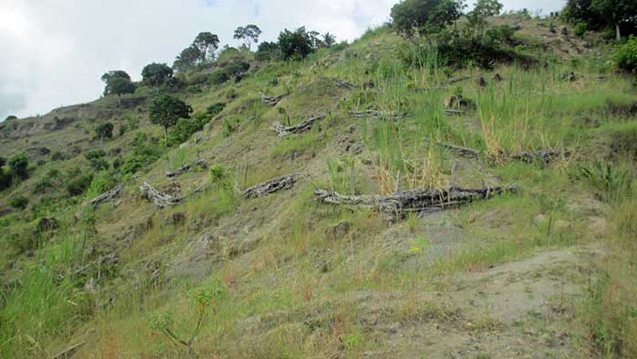
Did you know that Truthout is a nonprofit and independently funded by readers like you? If you value what we do, please support our work with a donation.
Reforestation and soil conservation programs costing many hundreds of thousands of dollars in the Petit-Goâve region have resulted in hundreds of small ledges built of straw or sacks of earth. Eight to ten months later, in certain areas the earthworks seem to be lasting. But in many others, these little “shelves” have disintegrated.
The construction and destruction of the anti-erosion ledges – all made with development assistance and humanitariandonations – offer an example of how at least some of Haiti’s reforestations projects turn out. In some cases, at least, they could be considered vicious circles.
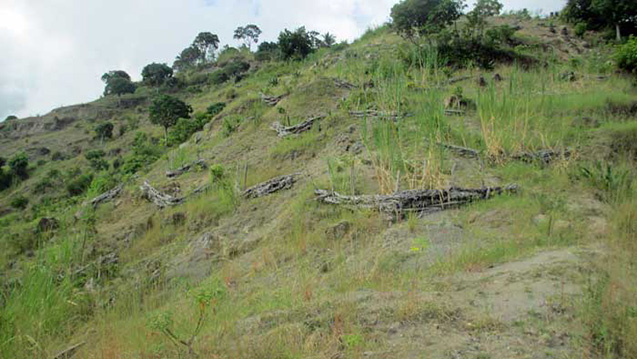 A hillside in the 11th communal section of Petiti-Goâve where the ledges are more or less functioning, with small plants growing in the soil. Photo: HGW/Milo Milfort
A hillside in the 11th communal section of Petiti-Goâve where the ledges are more or less functioning, with small plants growing in the soil. Photo: HGW/Milo Milfort
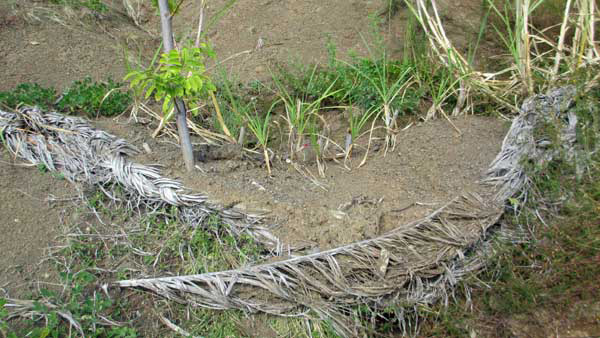 A ledge built with dried grass surrounded by peanut plants in Doucet, 11th communal section of Petit-Goâve on October 18, 2013. Photo: HGW/Milo Milfort
A ledge built with dried grass surrounded by peanut plants in Doucet, 11th communal section of Petit-Goâve on October 18, 2013. Photo: HGW/Milo Milfort
In the years since the 2010 earthquake, the 11th and 12th communal sections of Petit-Goâve, 60 kms. southwest of the capital, have hosted many soil conservation and agricultural programs. The U.N.’s Food and Agricultural Organization (FAO), Helvetas and Action Agro Allemande (AAA), sometimes working with a local development organization – Mouvman Kole Zepòl (MKOZE) – carried out several projects aimed at rehabilitating the watershed of the Ladigue River.
The steep slopes around the river “are very vulnerable to water erosion and mudslides,” MKOZE explained in a report on a project that had a budget of US$ 91,534. “During rainy season, the waters from the Ladigue River dump a lot of sediment and rocks at the river’s mouth, destroying fields and causing homes to flood. Sometimes harvests, homes, animals and even human lives are lost.”
Deforestation is one of Haiti’s great challenges. In the Petit-Goâve region, the problem started about a half-century ago, according to many residents. It began with the devastating 1963 Hurricane Flora, which caused great damage and over 5,000 deaths in Haiti’s west and southern regions.
 A few of the ledges built with dried grass on a completely denuded hillside in August 2013 in Doucet. Peanut plants can be seen encroaching in the lower right-hand side of the photo. Photo: HGW/Milo Milfort
A few of the ledges built with dried grass on a completely denuded hillside in August 2013 in Doucet. Peanut plants can be seen encroaching in the lower right-hand side of the photo. Photo: HGW/Milo Milfort
Molière Jean Félix, 62, remembers. He has worked the land for 35 years.
“There were a lot of mango trees at the top of this mountain. We grew corn and rice. Now you can’t even plant Congo beans there. Certain areas were forests! But today it’s more like savannas that won’t even support peanut plants,” recalled the farmer, who is today a member of a watershed protection committee.
In Haiti, trees are cut down mostly for energy uses. Most energy consumed in the country for cooking, for industrial bakeries and for dry cleaning – 75 percent of all energy used – comes from wood and charcoal,according to government figures. Félix sees tree-cutting almost every day.
“Today, young people don’t have any way to make a living. They don’t produce coffee, they don’t raise pigs. So, they cut down trees in order to send their children to school,” he said.
Recently, steps were taken to combat the region’s deforestation. Supervised by technicians, farmers and other residents of the 11th and 12th communal sections were paid 200 to 300 gourdes a day (US$4.65-US$6.98) to build ledges made of sacks of dirt, dried reeds and wattle. Funded by the FAO, AAA, Helvetas and the European Community Humanitarian Office (ECHO), the teams then planted fruit or other trees inside the new structures.
The reforestation projects serve a second purpose, according to AAA and other organizations, since they provide direct financial support to people after natural disasters. According to Beate Maas, coordinator of AAA in Haiti, these “Cash for Work” (CFW) projects help families build up their capital quickly.
“[CFW] helps us hire a lot of families and assures that they get a minimal revenue. This provides immediate assistance and is therefore a real advantage,” she told Ayiti Kale Je (AKJ).
But the “salary” does not satisfy the farmers.
“That miserable amount of money lasts only two or three days,” according to Olivia Batichon, a farmer and a member of the local group Organization of Youth in Action for Development (OJAD).
Batichon and other critics claim that when someone does a CFW job, which usually lasts two weeks, they neglect their fields.
But an AKJ poll of 50 CFW beneficiaries in Doucet revealed that all of the beneficiaries appreciate the jobs. According to respondents, even though the payment is small, it is useful, and it also helps by contributing to reforesting the area, they noted.
Reforestation vs. Everyday Needs?
All around Doucet, the hills are decorated with hundreds of the new little ledges holding seedlings of fruit or forest trees, like eucalyptus. But there are many slopes where the ledges are disintegrating: mud is spilling out, the saplings are dead or dying. Farmers have planted peanuts, peas and other crops around the structures. In a few months, the hillsides will be a naked as they were before the reforestation project.
Ilomène Tataille is a mother, a landowner, and is a member of one of the voluntary committees set up to keep an eye on the ledges and the new plants, to assure that animals don’t eat them and to make sure the ledges are drained after each rainfall. Another task, she explained, is to make sure that farmers don’t plant anything on the eroding slopes, and especially not peanuts, a popular crop in the region.
According to Tataille, even though the CFW workers and landowners all agreed at first not to disturb the hillsides, it is almost impossible to stop people from farming. Even she breaks her promise.
“Yes, I plant there, also. We live in a very dry region. We can only farm peanuts. That is our profession. Sorry, but we don’t have any other job!” she explained.
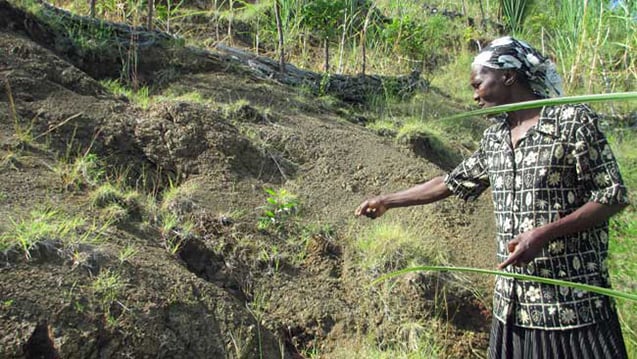 Ilomène Tataille points out some of the seedlings that were planted but that are having a hard time developing because of the lack of follow-up in Doucet, the 11th communal section of Petit-Goâve, on October 18 2013. Photo: HGW/Milo Milfort
Ilomène Tataille points out some of the seedlings that were planted but that are having a hard time developing because of the lack of follow-up in Doucet, the 11th communal section of Petit-Goâve, on October 18 2013. Photo: HGW/Milo Milfort
Tataille noted that another problem is the fact that landowners lease out their land, so even if they have told AAA and MKOZE they won’t work the land, they can’t force their renters to follow suit.
The staff who work on the projects admit to the challenges. Agronomist Esther Paynis was a consultant to AAA for a project carried out with MKOZE between September 2012 and August 2013.
“We told people not to plant peanuts and other crops that involve digging into the earth, like yam and sweet potato. In the training sessions we held, everyone promised to respect those principles,” Paynis told AKJ in a September 30 2013 email. Paynis said she supervised the construction of rock and earth-sack ledges for 1,180 sq. meters of land, and wattle ledges for another 2,000 sq. meters.
“If we give them advice that they later ignore, that’s not our fault. We told them the disadvantages of planting peanuts and how that could lead to the total degradation of the zone,” she continued.
During a visit in August 2013, journalists saw many young peanut plants on a number of hillsides near the ledges. Two months later, in October, recently made structures on many of those same hillsides were in various states of disintegration. Many had been destroyed and tree saplings and other plants were dead, either drowned or buried by earth, both the result of the lack of maintenance.
Criticism From Some
A few observers noted some bad choices made in the projects. For example, although Louis Calixte worked for AAA as a technician, he thinks the structures will not last.
“Some of the structures are good, but others are not good because of the kind of tree they planted. You can’t just plant a mango any old place. You have to plant it in a certain environment, where it will flourish. The same goes for eucalyptus. You can’t put it in a place meant to produce food. In other words, each species is different,” Calixte explained.
In order to get an independent opinion, AKJ consulted an agronomist who had not worked on the project.
Ludson Lafontant, an agronomist who specializes in reforestation, works in Fond d’Oies in the mountains above Léogâne, 32 kms. south of the capital. After visiting many of the Petit-Goâve hillsides, Lafontant noted that the techniques used offer many advantages. For example, the dried grass used for some of the ledges will eventually decompose and serve as compost for weeds. However, the agronomist agreed that eucalyptus is not the best choice for reforestation.
“All plants use water” he said. “But these kinds of plants – eucalyptus and also neem – I would not put them near rivers or wells or farmers’ fields. They suck up all the water around them.”
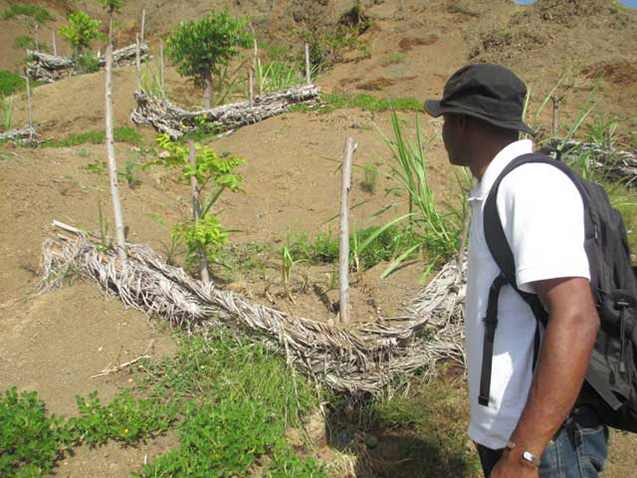 Agronomist Ludson Lafontant looks at the nearly denuded hillsides with recently constructed ledges, many surrounded by peanut plants, during a visit to Doucet in August 2013. Photo: HGW/Milo Milfort
Agronomist Ludson Lafontant looks at the nearly denuded hillsides with recently constructed ledges, many surrounded by peanut plants, during a visit to Doucet in August 2013. Photo: HGW/Milo Milfort
Lafontant and Calixte are not the only ones to complain about the choice of plants used. Molière Jean Félix, a Doucet landowner and a beneficiary of the reforestation project, is also worried.
“These trees use a lot of water!” Félix said. “When you plant them on your patch of land, they dry it right out and the land won’t produce anything after that.”
“Lave men siyè a tè?”
Junior Joseph, general secretary of OJAD in Beatrice, believes the choice of plants is not the only problem. The fact that reforestation might cause hunger – because farmers are asked not to plant their crops – is a major challenge. This contradiction can only lead to projects’ failures.
Another challenge stems from the fact that the committees established to watch over the ledges are made up of volunteers. They are responsible for maintaining the ledges, making sure their neighbors don’t plant or tie their animals to the small trees. Too little water will cause the plants to die, but too much will flood the ledges, which can cause the roots to rot and eventually kill the plants.
“The committees don’t have any support. Some people agree to work for free, but others do not,” Joseph said. “That’s when the structures deteriorate.”
Despite the fact that he worked as a technician for AAA, Calixte does not hesitate to criticize AAA for their failure to implicate local actors and to understand the needs of residents.
“A cow or goat is the peasant’s savings account,” Calixte explained.
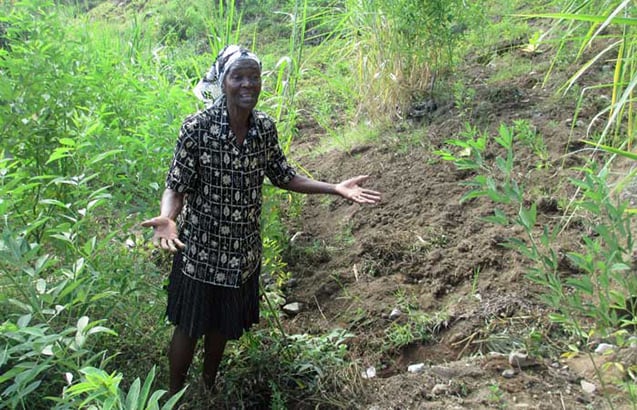 Ilomène Tataille explains that she has not been able to make her neighbors respect the principles to which they all agreed in Doucet. in the 11th communal section of Petit-Goâve, on October 18 2013. Most of the ledges in this area have been destroyed. Photo: HGW/Milo Milfort
Ilomène Tataille explains that she has not been able to make her neighbors respect the principles to which they all agreed in Doucet. in the 11th communal section of Petit-Goâve, on October 18 2013. Most of the ledges in this area have been destroyed. Photo: HGW/Milo Milfort
Agronomist Lafontant agrees. Reforestation is necessary but failure to implicate local farmers is a big problem. Another is the fact that the ledges are not built in a manner that takes into account the fact that farmers will plant on or near them, no matter what they have promised.
“You can’t stop a peasant who wants to work his little piece of land,” Lafontant said. “If it were me, I would close off these structures you see here, but I would build little contours with level shelves where they could plant their peanuts.”
Willio Saint-Cyr, coordinator of MKOZE, which oversaw at least two of the projects, admits to the challenges, but did not offer much of a solution.
“When you do these kinds of activities and when there is no follow-up or surveillance, it is probable that the work you did is erased, and things go back to how they were or even worse. This is because there are always ill-intentioned people,” he claimed.
During a visit in August 2013, Lafontant said he feared the reforestation project would be another example of wasted money, of the Haitian proverb “Lave men siyè a tè,” which means “wash you hands, dry them on the ground.”
But Lafontant also criticized the population and the government.
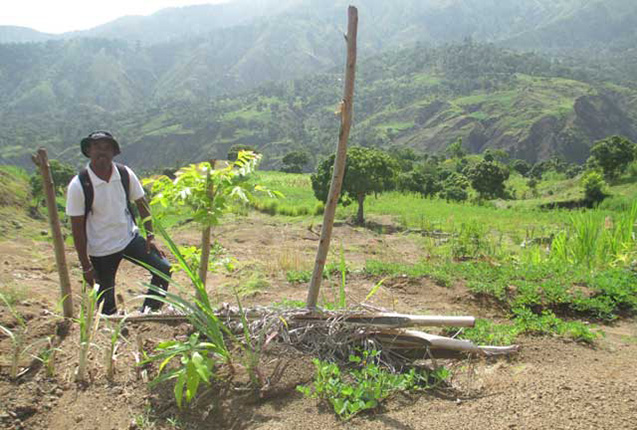 Agronomist Ludson Lafontant looking at one of the recently constructed ledges during a visit to Doucet in August 2013. It contains a young mango tree plant, a grass plant, and peanut plants. Photo : HGW/Milo Milfort
Agronomist Ludson Lafontant looking at one of the recently constructed ledges during a visit to Doucet in August 2013. It contains a young mango tree plant, a grass plant, and peanut plants. Photo : HGW/Milo Milfort
“I always say we ought to love ourselves more than others love us. In other words, the non-governmental organizations come here, they write projects, they look for the money and they do the project,” he said. “The money has to be justified so they can be proud to say they have worked on a X number of hectares, built contours on a Y square meters of land and given Z number of people jobs. That’s how they justify their money. But whose problem is it? Whose country is it? It’s ours, here in our home. We need to become conscious of that.”
Media that fights fascism
Truthout is funded almost entirely by readers — that’s why we can speak truth to power and cut against the mainstream narrative. But independent journalists at Truthout face mounting political repression under Trump.
We rely on your support to survive McCarthyist censorship. Please make a tax-deductible one-time or monthly donation.